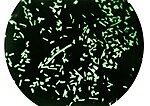Shigella is a genus of bacteria that is Gram negative, facultatively anaerobic, non–spore-forming, nonmotile, rod shaped, and is genetically nested within...
17 KB (1,635 words) - 08:02, 15 December 2024
Shigella dysenteriae is a species of the rod-shaped bacterial genus Shigella. Shigella species can cause shigellosis (bacillary dysentery). Shigellae are...
6 KB (621 words) - 14:51, 7 July 2024
Shigella flexneri is a species of Gram-negative bacteria in the genus Shigella that can cause diarrhea in humans. Several different serogroups of Shigella...
21 KB (2,322 words) - 23:45, 2 December 2023
Shigella sonnei is a species of Shigella. Together with Shigella flexneri, it is responsible for 90% of shigellosis cases. Shigella sonnei is named for...
8 KB (793 words) - 17:29, 15 March 2024
referred to as Dysentery) is an infection of the intestines caused by Shigella bacteria. Symptoms generally start one to two days after exposure and include...
23 KB (2,131 words) - 23:52, 24 September 2024
dehydration. The cause of dysentery is usually the bacteria from genus Shigella, in which case it is known as shigellosis, or the amoeba Entamoeba histolytica;...
36 KB (3,794 words) - 02:41, 5 November 2024
Shiga toxin (redirect from Shigella toxin)
Shiga, who first described the bacterial origin of dysentery caused by Shigella dysenteriae. Shiga-like toxin (SLT) is a historical term for similar or...
20 KB (2,313 words) - 14:46, 2 November 2024
Shigella boydii is a Gram-negative bacterium of the genus Shigella. Like other members of the genus, S. boydii is a nonmotile, nonsporeforming, rod-shaped...
3 KB (321 words) - 23:31, 19 August 2022
1897, Shiga was credited with the discovery and identification of the Shigella dysenteriae microorganism which causes dysentery, and the Shiga toxin which...
11 KB (1,182 words) - 04:17, 25 October 2024
species of Shigella are nested among E. coli strains (vide supra), while E. albertii and E. fergusonii are outside this group. Indeed, all Shigella species...
107 KB (11,156 words) - 00:00, 24 December 2024
agar) is a selective growth medium used in the isolation of Salmonella and Shigella species from clinical samples and from food. The agar was developed by...
3 KB (363 words) - 16:31, 8 December 2024
with bacillary dysentery: Shigella sonnei, Shigella flexneri and Shigella dysenteriae. A study in China indicated that Shigella flexneri 2a was the most...
8 KB (870 words) - 19:18, 5 December 2024
Taxon in disguise (section Shigella)
pathogens, it is generally avoided for some groups. The bacterial genus Shigella is the cause of bacillary dysentery, a potentially-severe infection that...
8 KB (909 words) - 15:21, 9 December 2024
familiar pathogens, such as Salmonella, Escherichia coli, Klebsiella, and Shigella. Other disease-causing bacteria in this family include Enterobacter and...
20 KB (1,885 words) - 17:40, 2 October 2024
Other common causes of infectious enteritis include bacteria such as Shigella and E. coli, as well as viruses such as adenovirus, astrovirus, and calicivirus...
19 KB (1,905 words) - 04:24, 18 October 2024
selective and differential agar primarily used to recover Salmonella and Shigella from patient specimens. HEA contains indicators of lactose fermentation...
4 KB (465 words) - 21:21, 12 September 2024
occur due to infection with Shiga toxin-producing Escherichia coli or Shigella species. HUS causes low platelet counts, poor kidney function, and low...
65 KB (6,513 words) - 22:02, 20 December 2024
with Shigella sonnei and Shigella flexneri and cross-reactions with Shigella antisera may occur. Plesiomonas can be distinguished from Shigella in diarrheal...
10 KB (1,014 words) - 13:12, 9 January 2024
Some of the most researched T3SSs are from species of:[citation needed] Shigella (causes bacillary dysentery), Salmonella (typhoid fever), Escherichia coli...
46 KB (5,863 words) - 04:12, 9 December 2024
Enterobacteriaceae. It is particularly useful in isolating Salmonella and Shigella. Lysogeny broth is used to culture Escherichia coli. MacConkey agar is...
19 KB (2,003 words) - 12:25, 20 December 2024
an invasion of bowel tissue. Dysentery is a symptom of, among others, Shigella, Entamoeba histolytica, and Salmonella. Diarrheal disease may have a negative...
86 KB (9,225 words) - 00:33, 26 November 2024
(AIEC), morbus Crohn Escherichia coli NC101 Shigella Shigella flexneri Shigella dysenteriae Shigella boydii Shigella sonnei Escherichia coli BL21(DE3) Braz...
3 KB (172 words) - 21:37, 18 November 2024
agents of acute enterocolitis are:[citation needed] bacteria: Salmonella, Shigella, Escherichia coli (E. coli), Campylobacter etc. viruses: enteroviruses...
4 KB (286 words) - 18:33, 16 October 2024
ferment lactose (e.g., E. coli) from those that do not (e.g., Salmonella, Shigella). Organisms that ferment lactose appear dark/black or green often with...
5 KB (431 words) - 11:25, 28 November 2024
Escherichia coli (ETEC). Enteroaggregative E. coli is increasingly recognized. Shigella spp. and Salmonella spp. are other common bacterial pathogens. Campylobacter...
38 KB (3,781 words) - 14:16, 30 November 2024
cholerae (cholera) Clostridioides difficile (pseudomembranous enterocolitis) Shigella (shigellosis / bacillary dysentery) Salmonella typhii (typhoid fever) Vibrio...
15 KB (1,420 words) - 21:16, 19 October 2024
Salmonella enterica Typhoid fever, Paratyphoid fever, Salmonellosis H2S− Shigella dysenteriae/sonnei/flexneri/boydii Shigellosis, Bacillary dysentery Proteus...
34 KB (3,477 words) - 05:13, 21 November 2024
in 1964, who noted it allowed for longer-term recovery of Salmonella, Shigella, Vibrio, and Pasteurella than other transport media. Cary–Blair transport...
2 KB (247 words) - 16:20, 8 December 2024
Salmonella enterica Typhoid fever, Paratyphoid fever, Salmonellosis H2S− Shigella dysenteriae/sonnei/flexneri/boydii Shigellosis, Bacillary dysentery Proteus...
33 KB (3,618 words) - 11:34, 17 December 2024





















